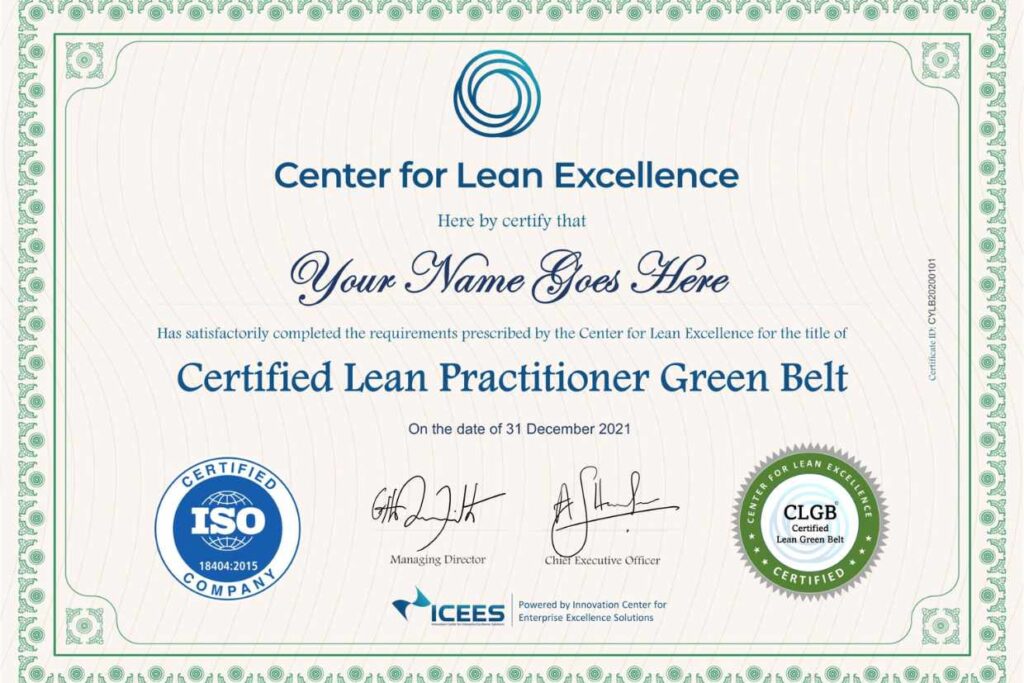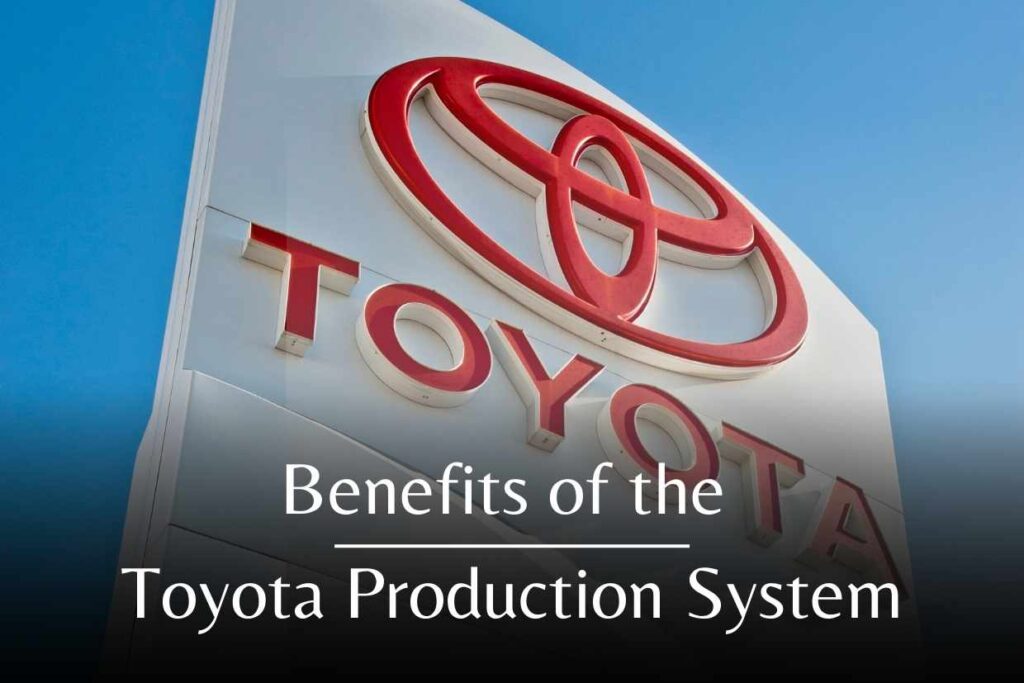Lean management Green belt training is a lean certification that is equivalent to a certified Lean practitioner, and it is mostly recommended for Directors, Senior Managers, Managers, and Assistant Managers in organisations. Only after the completion of Lean management Yellow belt certification, this Lean management Green belt training can be followed.

A thorough program, lean management green belt training covers a wide range of subjects, such as lean management principles, Lean management pillars, statistical analysis, process mapping, project management, problem-solving, and Lean A3 visual presentation skills. The purpose of the training program is to equip participants with the knowledge and abilities needed to lead lean management initiatives inside their organisations, locate waste, and enhance processes.
The standard curriculum of a proper Lean Green belt training program is given below.
-
-
-
-
-
- Introduction to Lean Management
- 8 Types of Wastes and Practical Applications
- 5S for Productivity
- Lean Process Mapping
- Introduction to Value Stream Mapping
- Gemba Kaizen for Continuous Improvement
- Systematic Problem Solving
- A3 Thinking
- Lean Metrics
- Quality Circles
- 8 Step problem solving
- Pull System, Kanban and Hijenka load levelling
- Total Productive Maintenance
- Quick Changeover (SMED)
- Error proofing and self-ownership
- Managing kaizen events
- Lean A3 visual presentation skills
- Lean Project Management
-
-
-
-
What will you learn in the Lean Management Green belt training?

01. 8 Types of Wastes
The Lean management Green belt training programs will give an insight into the 8 types of waste identified in Lean management and their practical applications. They are as follows.
- Overproduction: the act of producing more than is necessary for the consumer or the subsequent step in the production process.
- Waiting: Idle time that occurs when workers or machines are waiting for materials, information, or equipment.
- Transport: Unnecessary movement of goods or commodities between operations or places.
- Overprocessing: Performing more operations or using more resources than necessary to produce a product.
- Excess inventory: the possession of extra supplies, finished goods, or parts than required, to satisfy consumer demand.
- Unnecessary motion: Excessive movement of workers or equipment that is not directly related to the production process.
- Defects: Creating faulty goods that need to be reworked, repaired, or scrapped.
- Unused talent: Not making the most of employees’ potential, such as by preventing them from contributing their thoughts, abilities, or information.
02. 5S for Productivity
The 5S methodology for increasing productivity is concerned with establishing and upholding a tidy and well-organised work environment. Sort, Set in Order, Shine, Standardize, and Sustain are the five 5S principles. Understanding 5S for productivity is a crucial learning objective for green belt certification because it gives professionals the know-how and abilities to establish and maintain a productive and organised work environment, which boosts output and profitability. The Lean management Green belt training will train the professionals to apply this concept in the business.
03. Lean Process Mapping
This methodology aids in finding and removing inefficiencies in corporate processes. It entails outlining a process’ steps, spotting inefficiencies or waste, and redesigning the procedure to increase effectiveness and cut waste. The Lean management Green belt training provides knowledge to professionals to raise quality, lower costs, and boost customer happiness by implementing lean process mapping in their businesses.
04. Value stream mapping
Value stream mapping is a tool for visualising and analysing how information and materials move through a process from beginning to end. In order to develop ideas for improvement, it is used to locate waste, bottlenecks, and inefficiencies in a process. Businesses may increase productivity, cut down on lead times, and boost customer satisfaction by employing value stream mapping that is taught and given practice in the Lean management Green belt training.
05. Gemba Kaizen for Continuous Improvement
Gemba Kaizen is a methodology that emphasises ongoing development by incorporating front-line staff in the process. It entails locating inefficiencies or waste, making adjustments, and then evaluating the outcomes. After the Lean management Green belt training businesses are able to increase productivity, cut expenses, and boost customer happiness by implementing Gemba Kaizen.
06. Systematic problem solving
It is an approach for locating issues and finding logical, structured solutions to them. It entails identifying the issue, acquiring information, analysing that information, coming up with solutions, putting those solutions into practice, and observing the outcomes. The Lean management Green belt training teaches its practitioners how to raise customer satisfaction, lower expenses, and enhance quality by employing systematic issue resolution.
07. A3 Thinking
A3 thinking is a problem-solving technique that entails writing down a problem and its solution on a single piece of paper. It entails locating the issue, assessing the situation, coming up with solutions, putting those solutions into action, and observing the outcomes. The Lean management Green belt training gives its practitioners an idea of how to enhance communication, cut down on waste, and boost productivity by embracing A3 thinking.
08. Lean Metrics
Lean metrics are measurements that are used to assess how well lean projects are working. Cycle time, lead time, defect rate, and inventory turns are a few examples of the metrics they contain. The professionals of the companies who have participated in the Lean management Green belt training are able to evaluate the results of their lean projects, pinpoint areas for improvement, and make informed decisions by using lean metrics.
09. 8 Step problem solving
Organisations must be able to swiftly and efficiently solve challenges in order to stay ahead of the competition in today’s fiercely competitive business environment. The 8-step problem-solving process is a methodical approach to problem-solving introduced by lean management that focuses on locating and eliminating waste in order to increase productivity and quality. The Lean management Green belt training helps its participants to practice this proven methodology that aids businesses in identifying the causes of problems, coming up with workable solutions, and implementing those solutions to stop the problem from reoccurring.
10. Pull System, Kanban and Hijenka load levelling
A manufacturing system known as a “pull system” bases production on client demand. Contrary to a push system, where products are produced in response to forecasts or predetermined schedules, this method solely produces things in response to consumer orders. The Lean management Green belt training provides knowledge on how to use this strategy to lower the risk of excess production, waste, and inventory while ensuring that output is in line with actual demand.
Visual cues are utilised in Kanban, a common Pull System in manufacturing which is taught in Green belt traing, to notify when to start and halt production. Each stage of production in a Kanban system is given a specific number of cards, known as Kanban cards. When a consumer puts in an order, a Kanban card indicating that the necessary materials and pieces should be manufactured and sent to the following stage is sent to the stage before. The following stage can begin production as soon as they obtain the necessary supplies. Up until the finished product is made and delivered to the consumer, this process continues.
Another strategy for improving manufacturing production is Heijunka Load Leveling and the Lean management Green belt training certification holders know how to balance the workload among the production stages, including the production schedule using this concept. By doing this, the effort may be lightened, inventory can be kept to a minimum, and production can be made more adaptable and receptive to demand fluctuations.
11. Total Productive Maintenance
The goal of Total Productive Maintenance (TPM), a lean management strategy, is to increase the productivity and effectiveness of machinery and equipment used in industrial operations. TPM seeks to minimise the need for maintenance and repairs while ensuring that equipment is always ready to run at maximum efficiency, without any unscheduled downtime.
Companies can get a variety of advantages by implementing TPM that is taught in the Lean management Green belt training program, such as greater equipment availability and dependability, fewer maintenance costs, higher quality, and increased staff involvement and satisfaction. Other lean management initiatives, such as Just-in-Time (JIT) production and Total Quality Management, can benefit from TPM as well which is an important part of the Lean management Green belt training.
12. Quick Changeover (SMED)
A lean management strategy called quick changeover, also known as single-minute exchange of die (SMED), is intended to shorten the time needed to switch a manufacturing line from one product to another. This quick changeover taught in the Lean management Green belt training aims to reduce delays related to product changes while facilitating more frequent and effective production cycles.
People with Green belt certifications in companies can gain a variety of advantages by using Quick Changeover (SMED), including decreased downtime, higher productivity, enhanced quality, and increased flexibility in reacting to consumer demand. It is a useful tool in lean manufacturing, where quick turnaround times are required for productive and efficient output.
13. Error proofing and self-ownership
A lean management practice called error proofing, commonly referred to as Poka-Yoke, is used to stop flaws and mistakes in manufacturing processes. The goal of error-proofing is to create systems and processes that make mistakes either impossible or extremely difficult, hence raising product quality and decreasing waste.
Another crucial idea in lean management is self-ownership, which involves giving employees the freedom and authority to take charge of their own work. This entails empowering staff with the knowledge and tools they need to recognise issues at work, find solutions, and foster ongoing process and system improvement. Self-ownership is crucial for developing a culture of continuous development, where staff members are inspired to recognise issues, find solutions, and contribute to the success of the company as a whole.
Companies can benefit from improved product quality, decreased waste and defects, increased productivity, and a more engaged and motivated workforce by employing error-proofing and self-ownership in lean management. The knowledge of these methods is offered in the Lean management Green belt training and teaches practitioners how essential they are for developing a continuous improvement culture and making sure that production processes are optimised for optimal effectiveness and efficiency.
14. Managing kaizen events
Kaizen events, which involve a targeted, short-term improvement project and bring together a cross-functional team to discover and execute solutions to specific issues or opportunities in a manufacturing process, are a crucial part of lean management. Planning, carrying out, and assessing the results of these improvement projects are all part of managing kaizen events.
Organisations can get a variety of advantages by managing kaizen events well, including greater productivity, decreased waste and errors, improved process efficiency, and more engaged and motivated staff. Kaizen events are a crucial component of lean management because they allow businesses to continuously enhance their procedures and infrastructure in response to stakeholders’ and consumers’ shifting needs.
15. Lean A3 visual presentation skills
The problem, the analysis, and the suggested solutions are all documented on a single sheet of paper utilising the problem-solving method known as “A3 thinking” in lean management. The A3 format offers a clear, visual means of conveying complex information and involving stakeholders in the process of problem-solving. To clearly and concisely communicate the issue, analyse the circumstance, and provide remedies, one must possess effective A3 visual presenting skills, and Green belt training provides you exactly that. Lean management Green belt training practitioners may include stakeholders in the problem-solving process, convey complex challenges and answers in a clear and concise manner, and promote continuous improvement in their organisations by establishing good A3 visual presentation abilities.
16. Lean Project Management
The goal of lean project management is to increase the efficacy and efficiency of project delivery by fusing the principles of lean manufacturing with project management. Lean project management aims to minimise waste and shorten project completion times while maximising the value offered to consumers. Practitioners of Lean management Green belt training in organisations can benefit from implementing lean project management in a variety of ways, including faster project delivery, lower costs, higher quality, and happier customers. The method enables project teams to concentrate on providing value to clients while continuously enhancing the procedure to produce greater outcomes over time.
Benefits of Lean management Green belt training

The Lean management Green belt training offers a wide range of benefits, including providing individuals with the skills and knowledge necessary to improve efficiency, reduce costs, improve quality, enhance customer satisfaction, increase employee engagement, and gain a competitive advantage.
1. Improved efficiency and productivity
One of the main advantages of receiving Lean management Green Belt training is increased production and efficiency. In order to detect waste and inefficiencies in company processes and execute changes to simplify operations, participants in the Green Belt training program have a thorough understanding of Lean principles and techniques. Not only that, Green Belt certification holders can identify areas of the organisation that are producing delays or bottlenecks and execute process improvements to shorten lead times, remove waste, and boost overall efficiency by utilising Lean techniques like value stream mapping, process flow analysis, and root cause analysis.
Further, the participants in the Green Belt training program gain knowledge of how to use Lean tools and principles to streamline processes, shorten cycle times, and boost productivity. The firm may save a sizable amount of money as a result, and quality and customer satisfaction may also be improved. Additionally, the Green Belt training program equips participants with the abilities and resources needed to collaborate with their teams and coworkers, promoting a culture of continuous improvement that motivates workers and boosts productivity. Overall, the increased productivity and efficiency brought about by Green Belt training in Lean management can significantly affect an organisation’s bottom line, assisting it in achieving its objectives and maintaining its competitiveness in a business environment that is becoming more complex and fast-paced.
2. Reduce costs
The followings are some ways in which Green Belt training can lead to cost savings.
Eliminating waste: Green Belt training teaches participants how to locate and remove waste from business operations. This could involve extraneous processes in a process, an excessive amount of inventory, or flaws in a good or service. Organisations can lower expenses for goods, labour, and time by avoiding waste.
Minimising defects: Costs for rework, scrap, and warranty claims might grow as a result of product or service flaws. Individuals can learn how to apply statistical methods to locate and fix the primary causes of problems through green belt training. Organisations can lower the expenses linked to quality problems by minimising faults.
Boosting productivity: By learning how to use data to assess and enhance business operations through green belt training, businesses can save labour, material, and time expenses by increasing process efficiency.
Boosting customer satisfaction: Green Belt training places a strong emphasis on meeting customer expectations and demands. Organisations can boost revenue and save costs related to returns and customer complaints by increasing customer satisfaction.
Ultimately, Green Belt training can result in significant financial savings. Depending on the scale and complexity of the project, organisations that adopt Lean management initiatives can experience cost savings of thousands to millions of dollars. Businesses that invest in Green Belt training may provide their staff with the skills and knowledge to spot inefficiencies, cut waste, increase customer happiness, and save a lot of money in the process.
3. Career Advancement
Another key benefit of Green Belt training is the potential for career advancement that can result from mastering the skills and knowledge required to implement Lean Management principles in an organisation.
Here are some ways in which Green Belt training can lead to career advancement
Demonstrating expertise: Green Belt training gives them a thorough understanding of Lean Management principles and procedures, demonstrating proficiency. By using this knowledge, waste may be found and removed, processes can be improved, and organisational performance can be raised. People can increase their chances of being selected for promotions and leadership positions by showcasing knowledge in Lean Management to their subordinates and superiors.
Developing problem-solving abilities: Green Belt training shows participants how to recognise, evaluate, and resolve issues using Lean Management principles. Organisations place a high value on this skill set since it can result in better performance, more efficiency, and lower costs. Lean Management problem-solving experts are frequently seen as important assets by their firms and may be given consideration for leadership roles.
Collaboration and teamwork are improved: Green Belt training places a strong emphasis on the value of collaboration and teamwork in accomplishing organisational goals. Individuals learn how to collaborate productively with others to accomplish goals through group projects and activities. These abilities are highly appreciated in organisations and may open doors to greater responsibility and professional progression chances.
Bringing value to the organisation: People may offer value to their organisations by putting Lean Management ideas and practices into practice. This can entail lowering expenses, raising standards, boosting output, or increasing customer happiness. Senior management may acknowledge these accomplishments, which will boost prospects for professional growth.
Ultimately, a person’s job chances can be greatly improved by the abilities and information acquired throughout Green Belt training. Therefore, individuals can put themselves in a position for career growth and higher professional success by showcasing proficiency in the principles of lean management, developing problem-solving abilities, cooperation and collaboration, and bringing value to the firm.
4. Increased employee engagement
Increased employee involvement is another main advantage of Green belt training for lean management. When staff members receive this Green belt training, they learn how to find and get rid of waste in their work processes. Employees may feel more in control of their work and be able to contribute to the success of the company, which can assist to lessen frustration and boost job satisfaction. Moreover, Green belt training in lean management promotes employee cooperation and communication, which can result in a more upbeat and cohesive work atmosphere. Employees feel more connected to one another and are more inclined to cooperate to accomplish shared goals when they work together to identify problems and discover solutions.
Organisations may increase job satisfaction, lower attrition rates, and foster a more supportive and effective work environment by empowering employees to take ownership of their work processes after the Green belt training.
5. Producing high-quality products
The following are ways in which Lean Management Green Belt Training can lead to the production of higher-quality products:
- Improved Process Efficiency: Lean Management Green Belt Training enables employees to identify waste in the production process and eliminate it. This further results in a more efficient process that saves time, reduces errors and produces higher-quality products.
- Standardisation of Processes: Lean Management Green Belt Training also involves standardising processes to ensure that products are produced consistently and with minimal variation. This helps to improve the quality of the products and makes it easier to identify and address issues when they arise.
- Continuous Improvement: Lean Management Green Belt Training instils a culture of continuous improvement in employees, which leads to the identification and elimination of problems before they affect product quality. This, too, results in higher-quality products that meet customer requirements.
- Reduction of Defects: Lean Management Green Belt Training enables employees to identify and eliminate defects in the production process. This aids in reducing the number of defective products produced, resulting in higher-quality products that meet customer requirements.
- Customer Focus: Lean Management Green Belt Training emphasises the importance of understanding customer requirements and producing products that meet those requirements. That leads to the production of higher-quality products that meet or exceed customer expectations.
Summary
Lean management, which is a systematic method to reduce waste, boost productivity, and enhance quality, is taught to people through a certification program called lean management Green belt training. There, participants gain knowledge on how to spot process inefficiencies in their business and create solutions to boost output, cut down on lead times, and boost profitability. Organisations can obtain a competitive edge by employing lean management principles by providing high-quality goods or services at cheaper prices, which boosts market share and profitability. Lean Management Green Belt Training can help boost morale, job satisfaction, and engagement among staff members by including them in continuous improvement. In general, this Lean management Green belt training program equips participants with the abilities and information required to practice lean management successfully and promote ongoing development inside their organisations.




